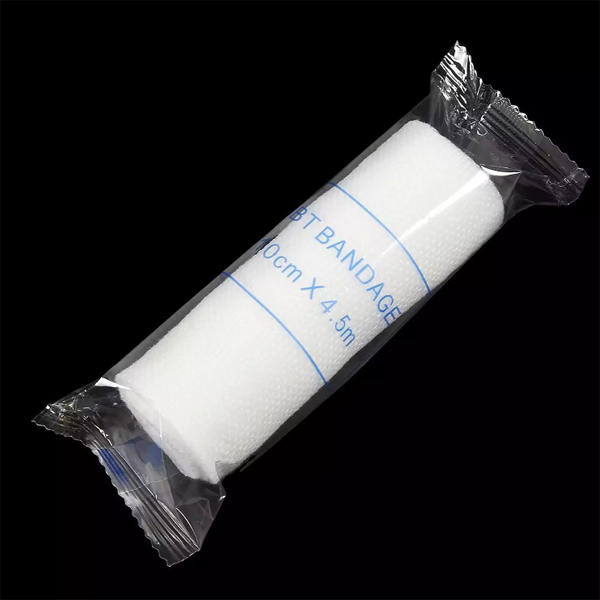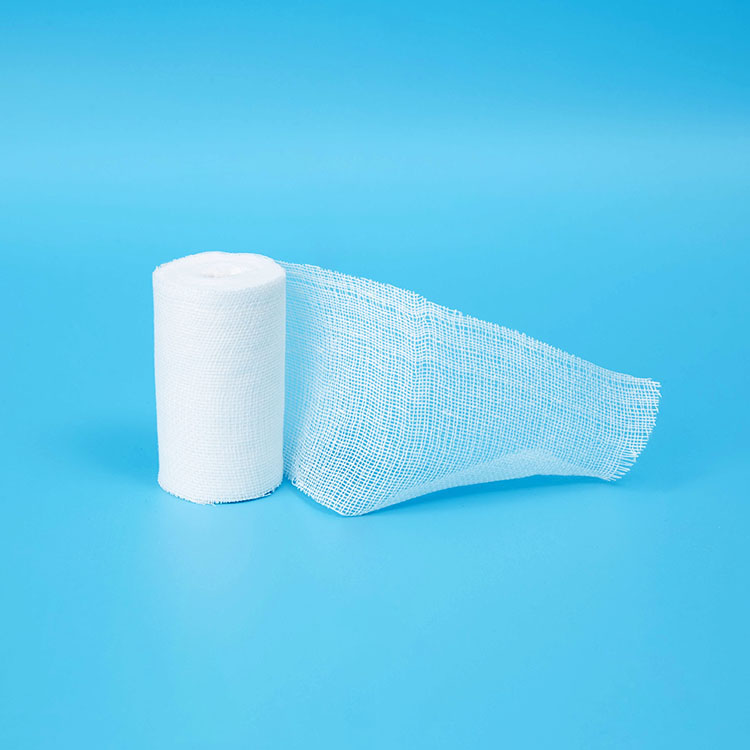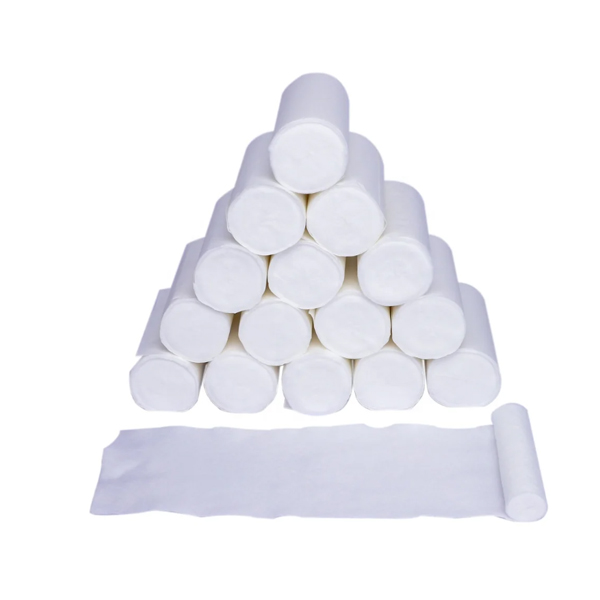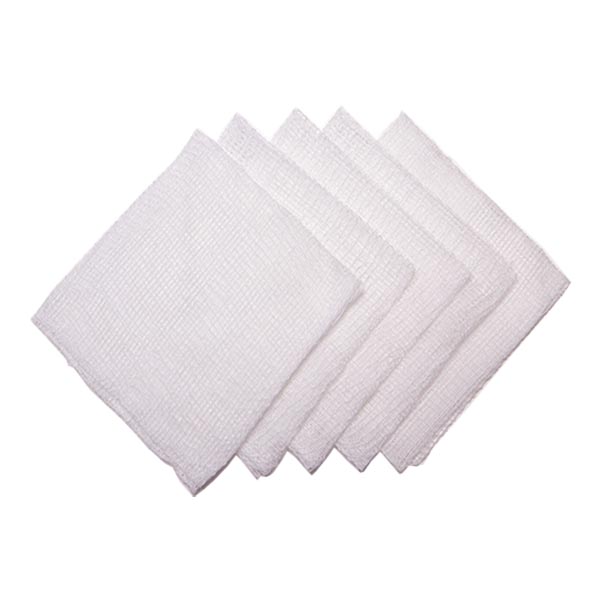When an injury occurs, quick and effective first aid can make all the difference. Among the essential first aid supplies, the humble gauze roll stands out as a remarkably versatile tool. Whether you’re a hospital procurement manager like Mark Thompson, stocking up on medical supplies, or simply ensuring your home first aid kit is complete, understanding the value of a quality gauze roll bandage is crucial. This article dives deep into the world of gauze bandages, explaining their types, uses, proper application, and why choosing the right supply matters for effective wound care and healing. Discover why this simple cloth, often made from cotton, is a cornerstone of managing everything from minor scrapes to more significant open wounds.
What Exactly is a Gauze Roll Bandage?
At its core, a gauze roll bandage is a strip of woven or non-woven material, typically made from cotton or synthetic blends, wound tightly into a roll. Think of it as a long, continuous piece of gauze fabric, ready to be cut or wrapped as needed. Unlike pre-cut gauze pads, the roll format offers incredible flexibility. You can cut a small piece to cover a minor cut or use a longer section to wrap around a limb, providing support or securing a dressing.
The primary function of a gauze roll is multifaceted. It acts as a primary or secondary dressing for a wound. As a primary dressing, it might be placed directly onto a cleaned wound to absorb blood and other fluids. As a secondary dressing, it’s often used to hold a primary dressing (like a non-stick pad or medicated gauze) in place, providing gentle compression and protection. Its construction allows for some breathability, which is vital for the healing process, letting air reach the injury while still forming a protective barrier.
We, as manufacturers, understand the essential role gauze plays. Our production lines focus on creating gauze rolls that are both soft and strong, ensuring they are comfortable against the skin yet durable enough for various medical needs. The weave of the gauze is carefully controlled to optimize absorbency and flexibility, making it a reliable choice for first aid and ongoing wound care. This simple roll is a foundational element in medical treatment.

Why is Gauze Roll a Staple in First Aid?
The presence of a gauze roll in virtually every first aid kit isn’t accidental; it’s a testament to its unmatched versatility and effectiveness. When emergencies strike, having a reliable supply of gauze is paramount. Its primary benefit lies in its adaptability. Whether dealing with a scrape, a cut, a burn, or a larger wound, a gauze roll can be configured to provide the necessary coverage and protection. You can easily cut it to fit the specific size and shape of the injury.
Furthermore, gauze rolls provide excellent absorption capabilities. They effectively manage bleeding and wound discharge, helping to keep the wound area clean. This absorbent quality is crucial in the initial stages of first aid. Additionally, when wrapped correctly, a gauze roll bandage can offer gentle compression to help control swelling and provide support to an injured area. Its lightweight nature makes it comfortable for the patient, unlike heavier bandage materials.
From a procurement perspective, like that of Mark Thompson needing supplies for a hospital, gauze rolls are cost-effective and indispensable. They serve multiple purposes, reducing the need for numerous specialized dressings. Having a good supply of quality gauze roll bandages ensures that healthcare providers are always ready for emergencies. It’s a fundamental component, whether for a professional setting or a simple home first aid kit. The gauze roll truly is a cornerstone of basic wound care.
How Do You Properly Apply a Gauze Bandage Roll?
Applying a gauze bandage roll correctly is key to ensuring it effectively protects the wound and promotes healing. It might seem straightforward, but following the right simple steps makes a significant difference. First, always ensure your hands are clean, or wear gloves if available, to prevent introducing bacteria to the injury. Clean the wound gently with antiseptic wipes or solution and pat it dry before applying any bandage.
If using the gauze as a primary dressing isn’t suitable (e.g., for deep wounds that might stick), place a sterile, non-adherent pad over the wound first. Then, begin wrapping the gauze roll starting below the injury and working upwards. Overlap each layer by about half the width of the gauze to ensure even coverage and pressure. The wrap should be snug enough to hold the dressing in place and control minor bleeding, but not so tight that it restricts blood flow. Check for signs of excessive tightness, like numbness, tingling, or the skin turning blue.
To secure the end of the gauze roll, you can use medical tape, safety pins, or clips. Some modern gauze rolls are self-adherent, eliminating the need for tape or clips – these are particularly convenient. If you don’t have tape, you can sometimes tuck the end of the roll under the previous layer, provided it feels secure. Remember to change the gauze bandage regularly, typically daily or if it becomes wet or dirty, to maintain a clean environment for the wound to heal. Learning to apply the gauze correctly is a vital first aid skill.

What Makes Sterile Gauze Bandages Different and Why is it Important?
The distinction between sterile and non-sterile gauze is critical, particularly in professional healthcare and serious first aid situations. Sterile gauze bandages have undergone a sterilization process (like autoclaving or irradiation) to eliminate all microorganisms, including bacteria, viruses, and fungi. Each sterile gauze roll or pad is individually packaged to maintain this sterility until it’s opened for use. This process is rigorously controlled in facilities like ours, adhering to standards like ISO 13485.
Why is sterility so important? When dealing with open wounds, broken skin, or surgical sites, the risk of infection is significant. Applying a non-sterile bandage directly to such an injury can introduce harmful pathogens, leading to complications, delayed healing, and potentially serious health issues. Sterile gauze creates a clean barrier between the wound and the external environment, minimizing the risk of contamination. This is absolutely vital when you apply the gauze directly to the wound.
For procurement managers like Mark, sourcing certified sterile gauze is non-negotiable for clinical use. Verifying sterilization methods and ensuring packaging integrity are key concerns. While non-sterile gauze rolls have their place – perhaps for providing padding, support over an intact primary dressing, or general cleaning – sterile gauze is the standard for direct wound contact, especially in hospitals, clinics, and for treating any significant injury. Always check the packaging: if it’s damaged or open, the gauze inside can no longer be considered sterile. Using sterile gauze bandages is a fundamental principle of safe wound care.
Are All Gauze Rolls the Same? Exploring Types and Materials
While the basic concept of a gauze roll is simple, there’s significant variation in types and materials, affecting their performance and suitability for different applications. Understanding these differences is crucial for selecting the right supply. As a manufacturer, we produce various types to meet diverse medical needs.
-
Material:
- Cotton Gauze: Traditionally, gauze is made from cotton. Cotton is known for its softness, absorbency, and breathability. It’s gentle on the skin, making it comfortable for patients. This is often the preferred choice for general wound dressing.
- Synthetic Blends: Gauze can also be made from synthetic fibers (like rayon or polyester) or blends. These might offer different properties, such as lower linting (leaving fewer fibers in the wound) or enhanced stretch.
- Non-Woven Gauze: Instead of a traditional weave, non-woven gauze is made from fibers pressed together. It’s often less linting and can be highly absorbent, sometimes feeling softer than woven gauze.
-
Weave/Construction:
- Tight Weave: Offers more strength and is less likely to snag, but might be slightly less absorbent or flexible.
- Loose Weave (e.g., Krinkle Gauze/Stretch Gauze): These rolls provide excellent flexibility and conformability, easily adapting to body contours. They offer good aeration and cushioning. Our Medical Cotton Gauze Bandage Roll is an example designed for comfort and stretch.
-
Specialty Gauze:
- Impregnated Gauze: Some gauze is treated with substances like antiseptic solutions (e.g., iodoform) or petrolatum (to prevent sticking).
- Self-Adherent Gauze (Cohesive Bandage): This type of gauze roll sticks to itself but not to skin or hair, eliminating the need for tape. It’s very convenient for securing dressings or providing light compression.
Choosing the right type depends on the specific wound, the required level of absorption, the need for conformity, and whether direct wound contact requires sterile gauze.
| Feature | Woven Cotton Gauze | Non-Woven Gauze | Stretch/Krinkle Gauze | Self-Adherent Gauze |
|---|---|---|---|---|
| Material | Cotton | Cotton/Synthetic Fibers | Cotton/Synthetic Blend | Elastic fibers, Latex/Latex-free |
| Structure | Woven threads | Pressed fibers | Loose weave, crinkled | Cohesive coating |
| Absorbency | Good | Often high | Moderate | Low (primarily for securing) |
| Flexibility | Moderate | Moderate | High | High |
| Use Case | General dressing, padding, absorption | Low-linting dressing, cleaning | Conforming bandage, securing | Securing dressings, compression |
| Need for Tape | Yes | Yes | Yes | No |
When Should You Use a Gauze Roll vs. Other Bandages (like Gauze Pads or Adhesive Strips)?
Selecting the appropriate bandage is crucial for effective first aid. While gauze rolls are incredibly versatile, they aren’t always the best choice for every single injury. Knowing when to use a roll versus other options like gauze pads or adhesive strips ensures optimal care.
Use a Gauze Roll When:
- Securing Dressings: The primary use of a standard gauze roll is often to hold a primary dressing (like a sterile gauze pad or non-adherent pad) securely against a wound. Its length allows it to be wrapped around limbs or contoured body parts.
- Providing Light Compression: Wrapping a gauze bandage can help reduce swelling and provide support to a sprain or strain, alongside its use in wound care.
- Covering Larger Areas: For injuries that are too large for a simple adhesive bandage or standard gauze pad, a gauze roll allows you to create a custom-sized dressing or wrap.
- Areas Requiring Flexibility: The flexible nature of gauze rolls, especially stretch gauze, makes them ideal for bandaging joints like elbows or knees where movement is necessary. Our Soft Roll Bandage excels in these situations.
- Need for Absorption (as Secondary Dressing): While a primary gauze pad absorbs most discharge, the overlying gauze roll can provide additional absorption.
Use Gauze Pads When:
- Direct Wound Coverage (Sterile): Sterile gauze pads are designed for direct contact with cleaned open wounds to absorb fluids and provide a protective barrier. They are often the first layer applied.
- Cleaning Wounds: Gauze pads (sterile or non-sterile, depending on the task) are useful for cleaning or applying antiseptic solutions.
- Smaller Wounds: For smaller cuts or abrasions that don’t require extensive wrapping, a gauze pad secured with tape is often sufficient.
Use Adhesive Bandages (e.g., Band-Aids) When:
- Minor Cuts and Scrapes: These are designed for small, superficial injuries that have minimal bleeding or discharge. They combine a small absorbent pad with an adhesive backing for easy to use, all-in-one application. They are not typically suitable for larger or deeper wounds.
Understanding these distinctions helps ensure you use the right tool for the job, whether managing a hospital supply or a home first aid kit.

How Does Gauze Help Wounds Heal Effectively?
Gauze plays a surprisingly sophisticated role in the wound healing process, going beyond simply covering the injury. Its properties actively contribute to creating an environment conducive to natural healing. The primary way gauze helps is by managing moisture and exudate (wound discharge). Effective wound care often involves maintaining a balanced moisture level – not too wet, not too dry.
Gauze, particularly cotton gauze, is naturally absorbent. It wicks away excess blood and other fluids from the wound surface. This helps to clean the area, reduce the risk of maceration (skin breakdown due to excessive moisture), and remove substances that could impede healing or harbor bacteria. However, good quality gauze also allows for some breathability. This air exchange is important; it prevents the wound from becoming overly moist and helps the tissues receive adequate oxygen, which is vital for cellular repair.
Furthermore, a properly applied gauze bandage protects the wound from external contaminants like dirt and bacteria, acting as a physical barrier. This protection minimizes the chance of infection, a major complication that can significantly delay healing. By keeping the wound clean, protected, and managing exudate, gauze rolls and pads create an optimal setting for the body’s natural repair mechanisms to function effectively, allowing the wound to heal properly. The choice of gauze material and weave can influence these properties, highlighting the importance of selecting appropriate medical supplies.
Can Gauze Bandages Prevent Infection?
While gauze bandages themselves don’t contain active antimicrobial agents (unless specifically treated, like iodoform gauze), they play a crucial role in infection prevention. Their primary contribution is creating a physical barrier. A clean, properly applied gauze bandage shields the vulnerable wound from the environment, preventing dirt, debris, and airborne bacteria from entering the injury site. This is particularly important for open wounds.
The use of sterile gauze is paramount in minimizing infection risk, especially when the gauze is in direct contact with the wound. As discussed earlier, sterile gauze is free from microorganisms. Applying it ensures that no new contaminants are introduced during the dressing process. This sterile field is the first line of defense against infection introduced during first aid or wound care.
Additionally, the absorbent nature of gauze helps manage wound exudate. Excessive moisture or pooling fluid can create a breeding ground for bacteria. By absorbing this discharge, the gauze bandage helps keep the wound cleaner and reduces the conditions favorable for bacterial growth. Regularly changing the bandage is also essential to remove absorbed fluid and any potential contaminants, further reducing the risk of infection. Therefore, while not an antiseptic itself, a gauze bandage is a vital component of an infection control strategy in wound management.

Choosing the Right Gauze Roll: Key Factors for Procurement Professionals
For procurement managers like Mark Thompson, sourcing gauze rolls involves more than just finding the lowest price. Ensuring a consistent supply of high-quality, reliable gauze that meets clinical needs and regulatory standards is essential. Here are key factors to consider:
- Material and Type: Understand the clinical needs. Is soft, absorbent cotton gauze preferred for general use? Is low-linting non-woven gauze required for specific procedures? Do you need highly conformable stretch gauze rolls (like these) for joints? Specify the required type clearly.
- Sterility: Determine the need for sterile gauze rolls versus non-sterile. For direct wound contact, sterile gauze is mandatory. Verify the supplier’s sterilization methods and certifications (e.g., ISO 13485). Ensure packaging integrity is maintained during shipping and storage.
- Quality and Compliance: Look for manufacturers with robust quality management systems (QMS). Certifications like ISO 13485 and CE marking (for Europe) indicate adherence to international standards. Request documentation and batch traceability records. Consistent quality is non-negotiable in medical supplies.
- Size and Ply: Gauze rolls come in various widths (e.g., 2-inch, 4-inch, 6-inch) and lengths. Ply refers to the number of layers; higher ply generally means greater absorbency and cushioning. Order sizes appropriate for the intended applications within the healthcare facility.
- Absorbency and Breathability: Ensure the gauze meets required absorbency levels for managing exudate effectively while still allowing for adequate breathability to support healing. Request product specifications and samples for evaluation if possible.
- Supplier Reliability: Consider the manufacturer’s production capacity (we operate 7 lines to ensure consistent supply), lead times, communication efficiency, and track record. Shipment delays can cause critical shortages, a major pain point for procurement. Choose partners known for reliability.
- Cost-Effectiveness: While price is a factor, balance it against quality, compliance, and reliability. The cheapest option may not be the most cost-effective if it fails in quality or causes delays. Look for value – a high-quality, compliant gauze roll at a competitive price point.
Addressing these factors helps ensure that the gauze roll supply meets the demanding standards of healthcare environments and supports optimal patient care.
The Importance of Quality Gauze in Professional Healthcare Settings
In hospitals, clinics, and other professional healthcare settings, the quality of basic medical supplies like gauze rolls cannot be overstated. While seemingly simple, gauze is used constantly in critical situations, from emergency rooms treating trauma injury cases to operating theatres for post-operative wound dressing, and routine wound care on the wards. Inferior quality gauze can have significant negative consequences.
Poorly manufactured gauze might shed fibers (lint), which can contaminate a wound, act as a foreign body, and impede healing. Inconsistent absorbency can lead to inadequate management of exudate, increasing infection risk or requiring more frequent bandage changes, thus increasing costs and clinical workload. If a sterile gauze bandage package is compromised due to poor quality seals, the sterility is lost, potentially leading to dangerous infections, especially in surgical settings or for immunocompromised patients. Lack of flexibility or excessive roughness can cause patient discomfort or even skin irritation.
Therefore, relying on manufacturers committed to high standards, like ZhongXing Medical, is crucial. We understand that every gauze roll, every gauze swab, and every bandage we produce plays a part in patient safety and recovery. Consistent quality control, adherence to international standards (ISO, CE), and reliable performance are not just features – they are essential requirements. For healthcare providers, knowing their supply of gauze is dependable allows them to focus on what matters most: treating patients effectively and ensuring the best possible outcomes. Quality gauze is fundamental to quality care.
Key Takeaways on Gauze Rolls:
- Versatility: Gauze rolls are highly adaptable first aid staples used for securing dressings, providing light compression, covering larger wounds, and managing injury on flexible body parts.
- Types Matter: Choose the right gauze (woven, non-woven, stretch, cotton, synthetic) based on the specific need for absorbency, flexibility, and low linting.
- Sterility is Crucial: Always use sterile gauze for direct contact with open wounds or surgical sites to prevent infection. Check packaging integrity.
- Proper Application: Clean the wound, apply the gauze bandage snugly but not too tight, overlap layers, and secure the end properly using tape or the bandage’s cohesive properties.
- Healing Support: Gauze helps heal wounds by absorbing excess fluid, protecting from contamination (barrier function), and allowing breathability.
- Quality First: Especially for professional use, prioritize high-quality, compliant gauze from reliable manufacturers to ensure patient safety, effective wound care, and consistent performance. Factors like material, sterility, size, absorbency, and compliance certifications are key for procurement.
- Essential Supply: A gauze roll bandage is an indispensable item in every first aid kit and a fundamental component of healthcare medical supplies.
Post time: Apr-21-2025





